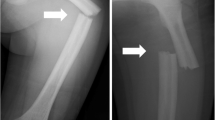Abstract
Pycnodysostosis is a rare hereditary disease, characterized by systemic bone sclerosis. The most important orthopedic problem in this condition is the recurrent pathological fracture of long bones. In this paper, the surgical results for fractures of six limbs (three femurs and three tibias) in five cases of pycnodysostosis are reported. Five limbs achieved fracture union and union is developing in one tibia after intramedullary nail (IM) nailing or Ilizarov external fixation (IEF), although fracture line tends to persist for longer periods of time. One femoral fracture was treated by IM nailing, and one femoral and one tibial fracture were treated by IEF leading to final bone union. One femoral and one tibial fracture were initially treated by IEF, and were treated by IM nailing after re-fracture. One tibial fracture was initially treated by IEF leading to a failure of union, and was converted to IM nailing. All cases are able to walk; one case requires a single crutch. Infection was noted in two limbs after IM nailing following IEF. Fixation with IM nail was effective in preventing re-fracture as well as in alignment correction. Although the surgical technique is more difficult, IM nailing in the initial surgery may be a better choice for achieving successful union while reducing the risk of re-fracture or infection.



Similar content being viewed by others
References
Edelson J, Obad S, Geiger R et al (1992) Pycnodysostosis. Orthopedic aspects with a description of 14 new cases. Clin Orthop 280: 263–276
Eltmore S (1967) Pycnodysostosis: a review. J Bone Joint Surg 49A:153–162
Emami-Ahari Z, Zarabi M, Javid B (1969) Pycnodysostosis. J Bone Joint Surg Br 51:307–312
Fratzl-Zelman N, Valenta A, Roschger P et al (2004) Decreased bone turnover and deterioration of bone structure in two cases of pycnodysostosis. J Clin Endocrinol Metab 89:1538–1547
Fujita Y, Nakata K, Yasui N et al (2000) Novel mutations of the Cathepsin K gene in patients with pycnodysostosis and their characterization. J Clin Endocrinol Metab 85:425–431
Gelb B, Edelson J, Desnick R (1995) Linkage of pycnodysostosis to chromosome 1q21 by homozygosity mapping. Nat Genet 10:235–237
Gelb BD, Shi G-P, Chapman HA et al (1996) Pycnodysostosis, a lysosomal disease caused by Cathepsin K deficiency. Science 273:1236–1238
Kato H, Matsuoka K, Kato N et al (2005) Mandibular osteomyelitis and fracture successfully treated with vascularised iliac bone graft in a patient with pycnodysostosis. Br J Plast Surg 58:263–266
Kundu Z, Marya K, Devgan A et al (2004) Subtrochanteric fracture managed by intramedullary nail in a patient with pycnodysostosis. Joint Bone Spine 71:154–156
Lyritis G, Rapidis A, Dimitracopoulos B (1982) Orthopaedic problems in patients with pycnodysostosis. Prog Clin Biol Res 104: 199–204
Marouteaux P, Lamy M (1962) Pycnodysostosis. Presse Med 70:999–1002
Meredith S, Simon M, Laros G et al (1978) Pycnodysostosis. A clinical, pathological, and ultramicroscopic study of a case. J Bone Joint Surg Am 60:1122–1127
Roth V (1976) Pycnodysostosis presenting with bilateral subtrachanteric fractures: case report. Clin Orthop 117:247–253
Acknowledgment
We thank Forte Technical Scientific and Corporate Communications for help in writing English.
Author information
Authors and Affiliations
Corresponding author
Rights and permissions
About this article
Cite this article
Nakase, T., Yasui, N., Hiroshima, K. et al. Surgical outcomes after treatment of fractures in femur and tibia in pycnodysostosis. Arch Orthop Trauma Surg 127, 161–165 (2007). https://doi.org/10.1007/s00402-006-0270-y
Received:
Published:
Issue Date:
DOI: https://doi.org/10.1007/s00402-006-0270-y




